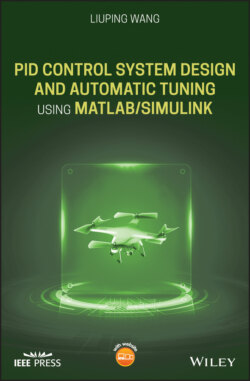Читать книгу PID Control System Design and Automatic Tuning using MATLAB/Simulink - Liuping Wang - Страница 38
Example 1.6
ОглавлениеThe unit step response of a continuous time transfer function model
(1.55)
is shown in Figure 1.15. Instead of using the first order plus delay model directly, we will find the PI controller parameters using the values of , , and delay .
Solution. A Simulink simulator is built to collect the step response testing data and to produce a figure for the step response. On this figure, a line is drawn to reflect the maximum slope of the reaction curve; there are two arrows marking the points of interest. Using MATLAB command ginput(2), with a click on the bottom point, we find the coordinates ; and with a click on the top point, we find .
From the readings of the two points, we find that
(1.56)
Figure 1.15 Unit step response (Example 1.6)
where is one since a unit step signal is used as the input. The time delay , and the parameter With these parameters, we calculate the PI controller parameters using the reaction curve based methods (see Tables 1.2, 1.3, and 1.6). The PI controller parameters are summarized in Table 1.7. Their closed-loop step responses are compared in Figure 1.16.
In reality, instead of a pure first order plus delay dynamics, there are more or less additional dynamics in the system. The tuning rules are applicable for a more complex system. We illustrate how to apply the tuning rules using the example below. This example also illustrates the fact that we need to be cautious when applying the tuning rules and be aware of their limitations.
Table 1.7 PI controller parameters with reaction curve.
| Ziegler–Nichols | 3.1714 | 63 | ||
| Cohen–Coon | 3.3381 | 32.7131 | ||
| Wang–Cluett | 2.0571 | 41.4811 |
Figure 1.16 Closed-loop unit step response with PI controller (Example 1.6). Key: line (1) Ziegler–Nichols tuning rule; line (2) Cohen–Coon tuning rule; line (3) Wang–Cluett tuning rule.
